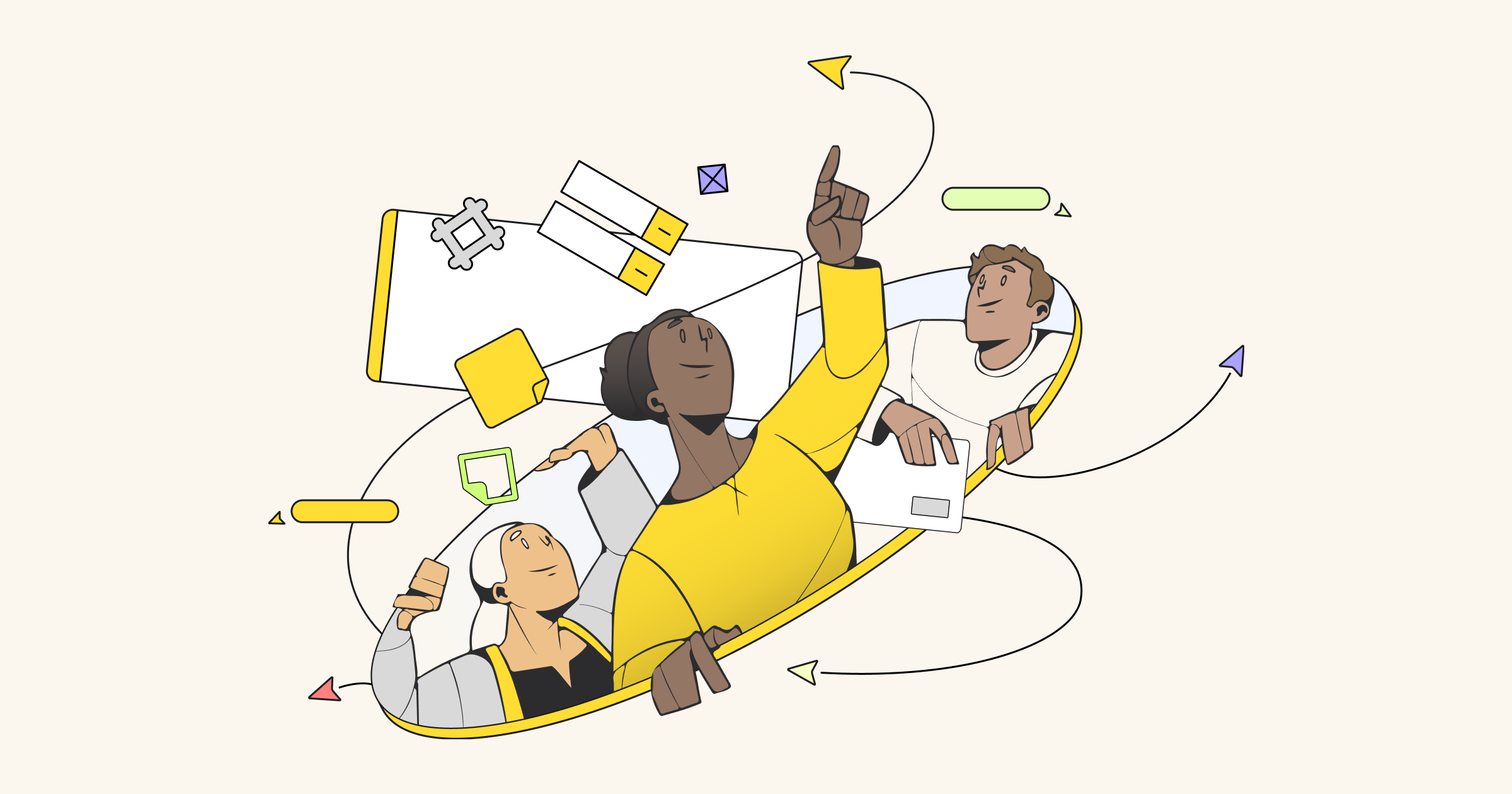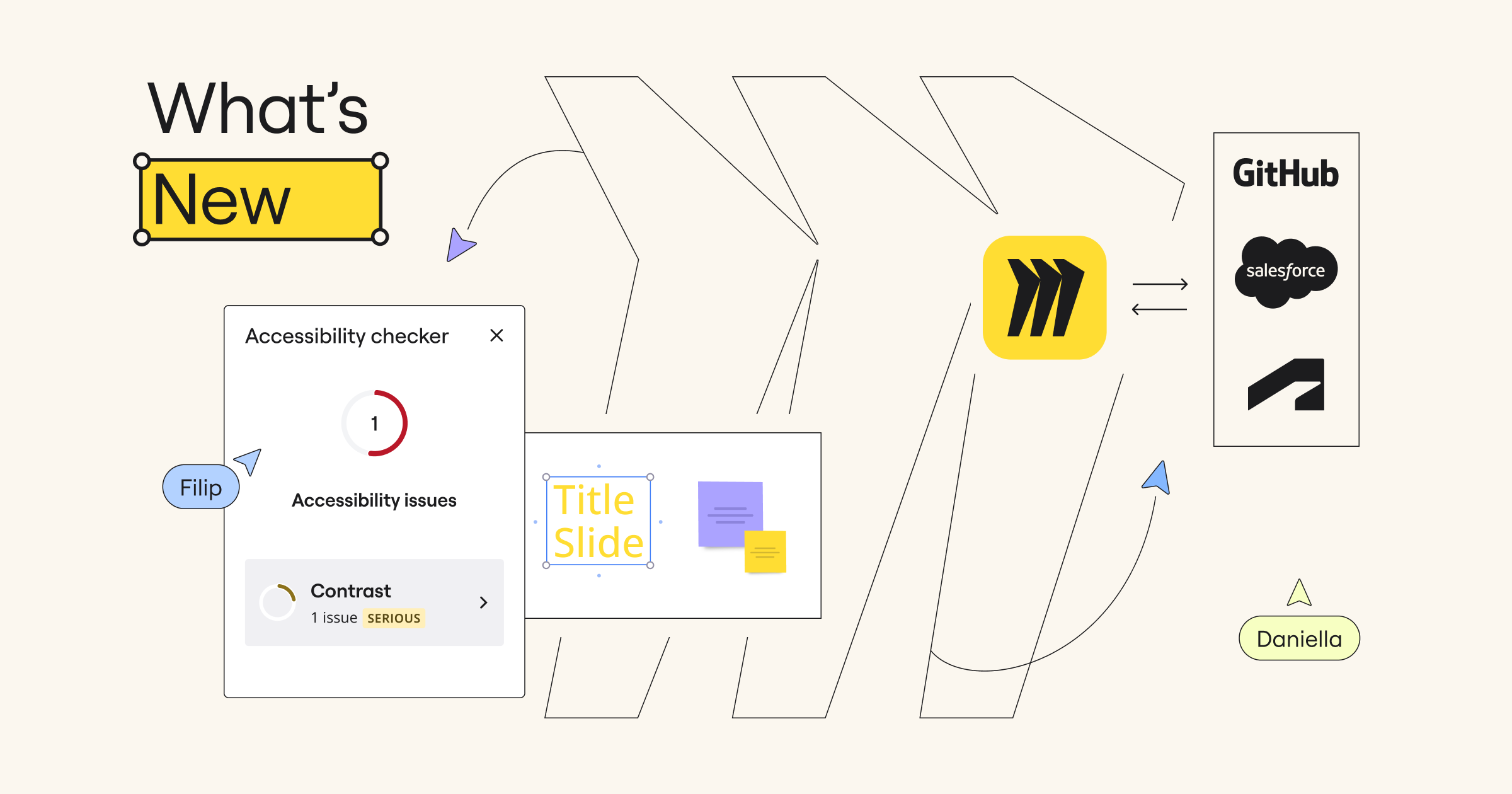4 ingredients to unlock your team’s creativity
July 29, 2022

There are a number of qualities that leaders hope their teams exhibit. Productive. Efficient. Collaborative. Engaged. But there’s another term that should rank near the top of this list: Creative. When McKinsey research shows that creativity is directly correlated with high performance, you want your team to feel empowered to bring their best ideas to the table.
So here’s the question: How do you unlock your team’s peak creativity?

Kat Boogaard
Contributing Writer for Miro
The formula for creativity: 4 ingredients of a creative team
It’s a tough question to answer, particularly since creativity feels nebulous — as if breakthroughs and lightbulb moments are the result of nothing more than random chance. As it turns out, the most inventive and visionary teams share four common elements that enable them to brainstorm big, bold, and out-of-the-box ideas.
Ingredient #1: Strong bonds and connections
Imagine you have an off-the-wall suggestion or a nugget of inspiration that you want to talk over. Who are you more comfortable sharing it with: A close, trusted friend or an acquaintance?Obviously, the dependable confidante is your go-to person, right? That same concept holds true for your team. They’re far more comfortable innovating if they feel a sense of security with the people they work with — and that’s why strong bonds and connections are crucial groundwork for creativity.
Research backs this up. One study found that teams who feel free to show and share their emotions with each other are far more creative.
It has a lot to do with psychological safety, which means that team members are comfortable voicing opinions and offering ideas without fear of judgment or reprimand. Put simply, when they feel a sense of familiarity and harmony, they’re more willing to speak up — even with their wildest ideas.
What to do next
Unfortunately, in-person team happy hours and informal watercooler chats have nearly disappeared as many teams shift to remote or hybrid work, so it’s harder than ever for people to build trust and forge strong bonds with their colleagues. Here’s how you can help them lay the foundation for solid relationships and improved creativity:
- Provide places and opportunities for casual chit-chat and social bonding. Something as simple as a dedicated Slack channel or a Zoom room where people can have coffee together can go a long way in building bridges.
- Encourage people to be vulnerable. Ahead of team meetings, check in on how people are feeling. It doesn’t need to be anything complex — it could be as easy as using an emoji reaction in response to your question (hey, the same part of your brain that processes real facial expressions also processes emojis).
- Foster candid conversations about successes, failures, risks, and learnings. Lead the way by being transparent about your own mistakes. When employees see leaders being vulnerable, they’re more likely to follow suit.
Ingredient #2: Impromptu brainstorming
You never know when inspiration will strike.While organized brainstorming sessions certainly have their time and place, people also benefit from an easily accessible place to jot down and collaborate on ideas asynchronouslyYour team deserves the resources to strike when the iron is hot. After all, it’s a positive cycle: You need a strong team to brainstorm effectively, but brainstorming actually builds a stronger team.
What to do next
Impromptu brainstorming is…well, unexpected and spontaneous. That makes it tough to plan for. However, there are some things you can do to set your team up for this type of unscripted collaboration and idea generation:
- Create a designated spot (a Miro board is perfect!) where people can scribble notes, hash out ideas, and store their random bits of inspiration.
- Use a Miro board to try brainwriting, where team members share ideas by writing them down instead of saying them out loud. Research shows that it’s an effective tactic for generating a lot of innovative ideas.
- Come up with some ground rules so that team members can easily tell if somebody is available to chew on an idea. For something easy, you could use Slack statuses (like, means “I’m focused on work and shouldn’t be interrupted” and means “I’m ready to be a sounding board for your big idea”).
Ingredient #3: Thoughtful alone time
Creativity might seem like it needs to be a group endeavor fueled by spirited conversations.
However, not all brilliant ideas are born out of collaborative sessions. In fact, some participants might keep their lips zipped because they fear a negative reaction from other people (it’s a concept known as “evaluation apprehension“).
That’s why some quiet, independent thinking time might be what your team needs to uncork their next big idea or identify a clever solution to a problem. One classic study out of Yale found that people working alone came up with twice as many answers to puzzles as those who were working in groups.
What to do next
Alone time for team members to noodle on their own thoughts is crucial, but it’s also tough to come by when excessive collaboration is the new normal. Here are a few ways to give your team the space they need to ponder and innovate on their own:
- Encourage team members to identify the times of day when they feel most energized and focused and reserve those times on their calendars for deep and creative work.
- Set up a shared digital workspace (this is another area where Miro can help) so people can easily access the information and resources they need to dig into problems and brainstorm solutions.
- When you do need to host a brainstorming session or team meeting, provide context ahead of time so people have time to think independently before attending.
- Make walking breaks a thing! Stanford research found that walking (whether inside or outside) gives creative inspiration a boost.
Ingredient #4: Equity of opportunity
The best ideas can come from anywhere, and research shows that culturally diverse teams are far more creative than homogenous ones.But, simply having a diverse team doesn’t lead to innovation. You also need to foster an open, inclusive, and supportive environment to make sure that everybody can confidently voice their own suggestions.
It’s an area where a lot of teams fall short, with almost half of respondents in one McKinsey survey reporting that they don’t feel very included in their organizations.
What to do next
Much like creativity itself, equity and inclusivity can feel difficult to wrap your arms around. Here are a few places to start:
- Before hosting any meetings or brainstorming sessions, think carefully about your attendees. Are there any voices missing? For example, a conversation about new features may be most productive if members of both the development and customer support teams are included.
- Have each team member create a personal user manual (here’s a template!). Everybody can get important information about the people they work with — their communication style, how they like to receive feedback, what drains or energizes them — at a glance.
- Come up with a challenge or a problem and then brainstorm questions rather than solutions. It’s a creative way to come up with ideas and also increases the comfort level for some of your introverted team members.
![]()
Because a question burst doesn’t demand that anyone instantly assert a point of view, people often feel more comfortable speaking up

What tools support creativity in a hybrid workplace?
If you’re worried about maintaining creativity on a remote or hybrid team, research shows that remote work actually has the potential to improve group creativity and ideation. By implementing the above strategies and technology, you will foster a team environment in which everybody’s best ideas can bubble to the surface. After all, impressive creativity already exists on your team — you just need to find the switch to turn on the lightbulb.
Learn more about how Miro can help your team work better together and pursue your biggest and brightest ideas



